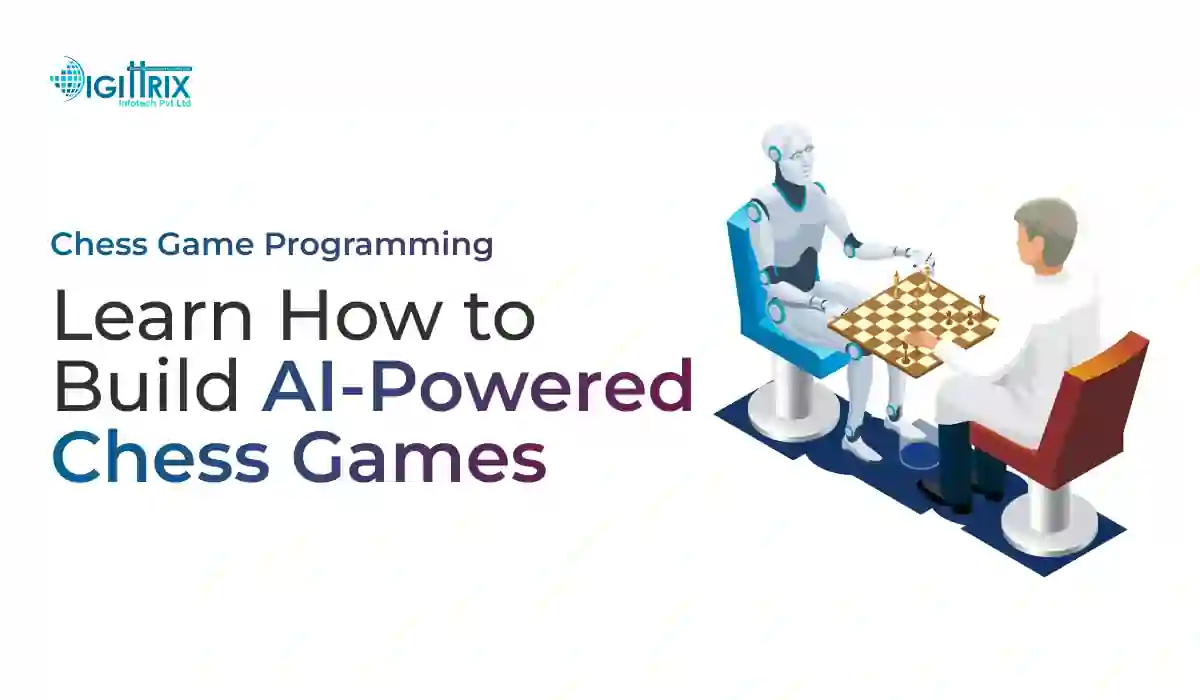SensorTower reports that global chess app downloads increased in 2024 as AI-powered and on-demand chess game apps gained strong popularity among all age groups.
Highlights
With Over 14 years of Experience in the IT Field, Helping Companies Optimise there Products for more Conversions

Chess has been a beloved pastime for centuries. From wooden boards in living rooms to digital apps on smartphones, the game remains as captivating as ever. Today, many developers are keen on creating their own chess games, especially with artificial intelligence (AI) features that allow players to compete against clever opponents. Developing an AI-powered chess game is not just an exciting challenge but also a growing opportunity for those interested in the gaming industry.
This article explains how chess game programming functions and what you need to know to develop an AI-powered chess game. Whether you’re working solo, with an app development company, or planning to launch an on-demand chess game app, the information below offers practical guidance for anyone keen to build a chess game app.
Looking for a Unity game development partner? Check Digittrix's in-depth article on what makes them the ideal choice!
At the core of any AI-powered chess game is a chess engine. A chess engine is the component of the program that calculates potential moves and selects the best one. These engines examine countless move combinations, weighing the advantages and disadvantages of each. This is where machine learning and traditional algorithms both come into play.
Modern chess engines often depend on search algorithms like Minimax, improved with techniques such as alpha-beta pruning. These methods assist the engine in looking several moves ahead without analysing every possible board arrangement. Instead, it bypasses branches that won’t enhance the game position.
Evaluation functions are just as crucial. These are mathematical formulas that assign scores to board positions based on factors like piece value, control of the centre, king safety, and pawn structure. Combining search and evaluation creates an AI opponent that can challenge players of different skill levels. According to Statista, Chess app downloads grew 18% worldwide during early 2024.
When developing a chess game app, your choice of programming language depends on the platforms you’re targeting and the performance level you require. Here are some popular options:
If you work with an app development company, they can help determine which language fits your budget, timeline, and target devices.
The chessboard interface might look simple—a 64-square grid—but it’s essential for a chess game app. The board must be clear, responsive, and visually appealing. When designing the UI, consider the following:
Your chess game mobile app should also be tested on devices with various screen sizes to ensure that buttons and board elements are easy to see and touch.
The core of any chess game app is the logic that manages piece movement, rules, and game states. Here’s what you need to handle in your code:
Testing these rules thoroughly is essential. Even small errors may cause a chess game app to seem untrustworthy.
Once your chessboard and game logic are set up, you need to connect your chess engine. Many developers choose to integrate existing engines like Stockfish rather than build one from scratch. Stockfish is open-source and highly powerful, making it a popular option for AI-driven chess games.
However, integrating an engine involves some work:
A strong chess engine makes a chess game app competitive in the market and offers a challenging experience to players.
Chess games often go for a long time, and players might want to pick up where they left off. You’ll need to save the game’s state, including:
Many chess game apps use Portable Game Notation (PGN), a standard file format that stores move sequences and game metadata. Supporting PGN also allows users to share their games online or study famous matches.
One of the biggest trends in chess game app development is online multiplayer. Players want to compete against friends or strangers worldwide. Adding multiplayer features involves:
Developing a multiplayer chess game can be complicated, so many developers choose to hire an app development company for this aspect of the project. AppMagic reports show that AI-powered chess games generated 22% more revenue worldwide in 2024.
User experience (UX) plays a huge role in how people rate a chess game mobile app. Consider adding these features to keep users satisfied:
A well-crafted user interface and thoughtful features will set your chess game app apart from the competition.
When launching an on-demand chess game app, you’ll probably want to generate revenue. There are a few models to consider:
It’s important to find a balance between earning revenue and keeping the app accessible for players.
Chess is a game with precise rules, and even minor bugs can ruin a player’s experience. Testing should focus on:
Automated tests help identify issues early. It’s also sensible to gather feedback from beta testers before launching your chess game app publicly.
If you’re not a programmer, you can hire an app development company to build your chess game app. They can handle:
An experienced team will help you bring your concept for an AI-powered chess game to life, saving time and effort.
Want to build your own game? Check Digittrix's step-by-step Unity tutorial to create a classic Snake game!
The market for chess games is competitive, so you’ll need to keep your app fresh and appealing. Here are some strategies:
A modern chess game app should do more than just let users play chess; it should offer a complete chess experience. SensorTower reports show that on-demand chess game apps reached 150 million downloads in 2024.
Programming a chess game involves logic, creativity, and technical skills. Making an AI-powered chess game requires understanding chess engines, designing user-friendly interfaces, developing robust game logic, and possibly including online multiplayer features. Whether you create your engine or use existing solutions, a careful approach will help you develop a chess mobile app that users enjoy.
For those planning an on-demand chess game app, working with an app development company can make the process easier and help you bring it to market faster. The demand for chess game app development keeps rising, fueled by the popularity of chess among both casual players and serious enthusiasts.
From classic chess matches to sophisticated AI opponents, chess continues to be one of the most engaging games to introduce into the digital realm. With the right tools and planning, your chess game app can secure its place among the favourites in app stores and keep players coming back for more matches.
Designing an AI-powered chess game is an intriguing journey that combines logical thinking with technical skill. Whether you’re aiming to create a traditional chess experience or introduce new features driven by intelligent algorithms, the development process spans from concept planning and design to coding and launching.
If you’re aiming to turn your chess game idea into reality, Digittrix is ready to assist. With many years of experience in mobile app development, we specialise in creating chess apps and AI integration, ensuring smooth performance on both Android and iOS platforms.
Want to start building your own chess game? Schedule a consultation with our skilled team today by calling +91 8727000867. For more details, reach out to us at digittrix@gmail.com.

Do you need help in Mobile App development?




Join over 1500+ businesses we've already helped!

©2025Digittrix Infotech Private Limited , All rights reserved.